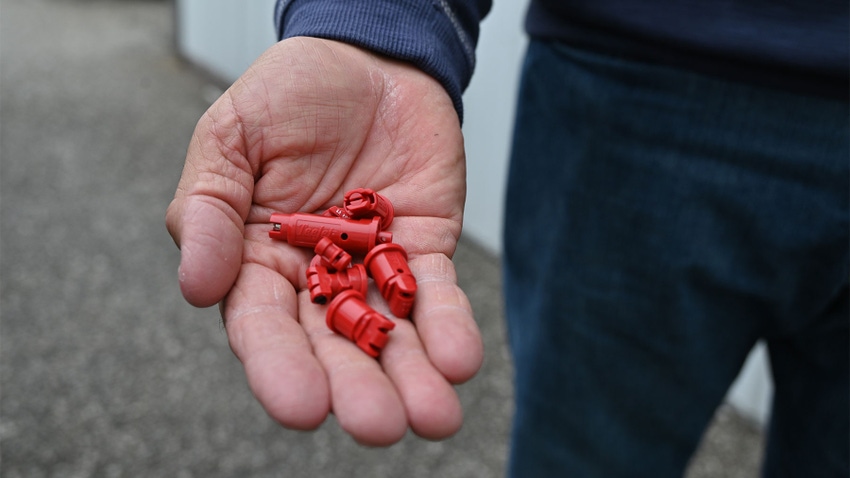April 17, 2024

Staring at a sprayer nozzle catalog can stir up a mix of emotions; confusion, frustration and anger are some that may rise to the top. One nozzle should not be used for all products — but that is easier said than done. So, where is the right place to start?
Greg Lundquist of Agro-Chem in Wabash, Ind., says the answer to that question is to first look at the label for the product you’re applying. The product label will list a spectrum of nozzles that are recommended, but Lundquist explains that those lists are typically vague.
To narrow down the options, Lundquist says he asks the producer when he or she plans to apply the product to determine the size of the crop. Considering this factor can help narrow the choices to a certain pattern type.
The nozzle catalog is your friend
Beyond those first few steps, the remaining guidance for finding the right nozzle is found inside a nozzle catalog. Lundquist explains that the TeeJet catalog, for example, features a variety of graphs, equations and explanations to make nozzle selection simple.
“The TeeJet book is awesome for information,” Lundquist adds. “If a grower would spend some time in there, they wouldn’t have to go any further, and they would know pretty much what they need. But unfortunately, they’re busy and don’t have the time for all of that.”
To save time, Lundquist has broken the remainder of the nozzle selection process into a few simple steps. Follow the process below:
1. Consider spacing. The TeeJet nozzle charts are rated for 20-inch nozzle spacing. If your spacing is different, head to the back of the book to find the formula for calculating the gallons per minute being sprayed. If you have 20-inch spacing, then follow the chart exactly to find the right nozzle.
2. Calculate GPM. Find the gallons per minute by multiplying gallons per acre by speed in miles per hour and the spacing between nozzles in inches. Then divide that number by the constant of 5,940 to determine the GPM.
For example, say you are going to apply a product at 20 gallons per acre traveling at 6 mph with 20-inch nozzle spacing. You would multiply those numbers to get 2,400. Divide 2,400 by 5,940 to get 0.404 GPM.
3. Match GPM to droplet size. Once you’ve calculated the GPM, browse through the nozzle charts to find options where the GPM aligns with the droplet size you plan to use, based on the product. There may be a handful of options to consider.
4. Consider pressure. Now, you will check out the pressure in pounds per square inch that is associated with the options you’ve found. You should find a PSI that works for the product you’re applying and what you would prefer to use.
Other nozzle considerations
At this point, you should have found one nozzle that will work best for the product being used. There are a few other factors to consider that could alter your decision. Lundquist says one of these considerations is whether to use an air-induction nozzle.
“When wind becomes a problem, then we want to add air and get a little bigger droplet,” Lundquist adds. If drifting is a concern, especially when there may be a garden nearby, then it may be best to play it safe and look for an air-induction nozzle.
Another item to ponder is whether to use a nozzle with a split pattern. If the application will be made later in the season when the crop is larger, then it may be best to use a split-pattern nozzle that can get the product through the canopy.
Finally, what carrier will you use? The above process can be applied to any carrier type, but the GPM formula assumes water is being used. Toward the back of the TeeJet catalog, a table shows how to calculate GPM based on carrier type. For example, if 28% nitrogen is the carrier, the GPM must increase by 13% before taking that number to the nozzle charts.
Although planting season tasks can drown out spraying preparations, Lundquist says it’s best to get familiar with the nozzle catalog of your choice. He notes that TeeJet has an app that makes nozzle selection even simpler.
“It basically boils down to knowing the chemical label,” Lundquist adds. “That’s a good starting point.”
About the Author(s)
You May Also Like






